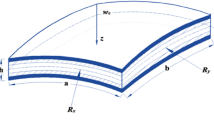Abstract
Based on the finite element method, numerical simulation models of a standard disc spring were built and force–displacement curves were obtained under different displacement loads. Then the static loading experiments were conducted by the tensile experimenting machine. The computation model was validated by comparison of the model predictions with the experimental results. The results of the numerical simulation model were in good agreement with the experimental data. Based on the finite element method, models of grooved disc springs were established. The force–displacement and stiffness–displacement curves for the disc springs with different groove configurations were obtained. And the results were verified by the experiment data. The effects of the distribution and number of the grooves on the load variation, the stiffness change, the negative stiffness region in the force–displacement curve were analyzed. The research has good reference value for the design of disc spring with negative stiffness and the application of negative stiffness part in reducing vibration and vibration isolation device.





























Similar content being viewed by others
References
Wang YH, Li WB, Wang CY, Tang B, Xie S (2013) Optimum design of disc spring for spacecraft based on finite element analysis. Missiles Space Veh 6:51–55
Du JM, Dai SX (2009) Research on dynamic characteristics of disc spring shock absorber. Eng Mach 40(11):15–18
Sun PM, Wei XB, Chen SQ (2013) Application of variable stiffness damper with disc spring to punch. Forg Stamp Technol 4:020
Hang H (2013) Mechanical performance experiment of disc springs and application analysis of three-dimensional seismic isolation bearing. Beijing Jiao tong University, Beijing
Niu F, Ren XD, Meng LS, Wu WJ, Meng G, Sun JG (2015) Design mechanism and application of quasi-zero stiffness isolator. Chin Med Equip J 36(5):34–36
Meng LS (2015) Design and characteristics analysis of the novel quasi-zero stiffness isolator. Military Medical Academy of Chinese People’s Liberation Army, Chongqing
Ozaki S, Tsuda K, Tominaga J (2012) Analyses of static and dynamic behavior of coned disk springs: effects of friction boundaries. Thin-Walled Struct 59:132–143
Patangtalo W, Aimmanee S, Chutima S (2016) A unified analysis of isotropic and composite Belleville springs. Thin-Walled Struct 109:285–295
Fawazi N, Yoon JH, Oh JE, Lee JY (2010) Geometric Design of a slotted disc spring for a prescribed force–displacement function,//ASME 2010 International Mechanical Engineering Congress and Exposition. Am Soc Mech Eng 2010:741–752
Fawazi N, Lee JY, Oh JE (2011) A load–displacement prediction for a bended slotted disc using the energy method. Proc Inst Mech Eng Part C J Mech Eng Sci 226(8):2126–2137
Sun J, Wu JG (1997) Nonlinear finite element calculation of disc spring curves. Mech Pract 19(4):49–50
Hou ZF, Zhang CL (1999) Calculation and analysis of disc spring. Eng Mech 1(a01):393–396
Liao RD, Zuo ZX (2006) Large deformation elastoplastic FEM analysis of a nonstandard disc spring used in separation of aerocrafts. Acta Armamentarii 27(4):702–707
Sun LM, Wang XB, Shi L (2007) Study on stiffness of composite disc spring. J Zhengzhou Univ (Engineering Science) 28(3):117–120
Wu R, Gao JH, Wu H (2010) Studies on static stiffness of disc spring based on the finite element technique. Mech Eng 8:57–59
Zhang ZY, Zhou BY, Zhou Y (2011) Properties analysis of disk spring by PDT. Mech Res Appl 2:7–9
Xing JH, Hang H, Zhang JY, Yang QS (2015) Mechanical properties of disc springs. J Vib Shock 34(22):167–172
Hu YX, Yao ZQ (2006) The time step choosing for FEM simulation of laser shock processing. J Shanghai Jiaotong Univ 40(10):1745–1747
Acknowledgements
The authors would like to express their appreciation to the grant from China Scholarship Council.
Author information
Authors and Affiliations
Corresponding authors
Additional information
Technical Editor: André Cavalieri.
Rights and permissions
About this article
Cite this article
Zhu, D., Ding, F., Liu, H. et al. Mechanical property analysis of disc spring. J Braz. Soc. Mech. Sci. Eng. 40, 230 (2018). https://doi.org/10.1007/s40430-018-1152-2
Received:
Accepted:
Published:
DOI: https://doi.org/10.1007/s40430-018-1152-2




